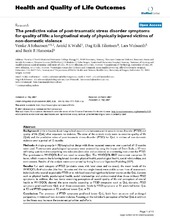| dc.description.abstract | Background: Little is known about longitudinal associations between post-traumatic stress disorder (PTSD) and quality of life (QoL) after exposure to violence. The aims of the current study were to examine quality of life (QoL) and the predictive value of post-traumatic stress disorder (PTSD) for QoL in victims of non-domestic violence over a period of 12 months. Methods: A single-group (n = 70) longitudinal design with three repeated measures over a period of 12 months were used. Posttraumatic psychological symptoms were assessed by using the Impact of Event Scale, a 15-item self-rating questionnaire comprising two subscales (intrusion and avoidance) as a screening instrument for PTSD. The questionnaire WHOQOL-Bref was used to assess QoL. The WHOQOL-BREF instrument comprises 26 items, which measure the following broad domains: physical health, psychological health, social relationships, and environment. Results of the analysis were summarized by fitting Structural Equation Modelling (SEM). Results: For each category of PTSD (probable cases, risk level cases and no cases), the mean levels of the WHOQOL-Bref subscales (the four domains and the two single items) were stable across time of assessment. Individuals who scored as probable PTSD or as risk level cases had significantly lower scores on the QoL domains such as physical health, psychological health, social relationships and environmental than those without PTSD symptoms. In addition, the two items examining perception of overall quality of life and perception of overall health in WHOQOL showed the same results according to PTSD symptoms such as QoL domains. PTSD symptoms predicted lower QoL at all three assessments. Similarly PTSD symptoms at T1 predicted lower QoL at T2 and PTSD symptoms at T2 predicted lower QoL at T3. Conclusion: The presence of PTSD symptoms predicted lower QoL, both from an acute and prolonged perspective, in victims of non-domestic violence. Focusing on the individual's perception of his/her QoL in addition to the illness may increase the treatment priorities and efforts. | en_US |
